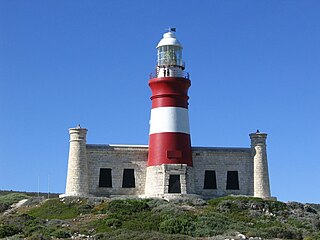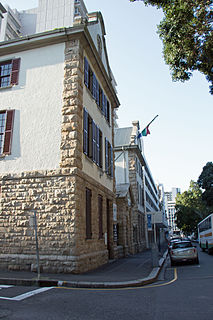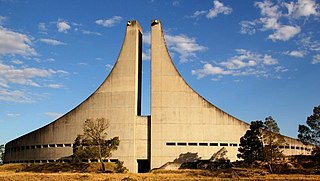 W
WThe 1820 Settlers National Monument, which honours the contribution to South African society made by the British 1820 Settlers, overlooks Grahamstown in the Eastern Cape. It commemorates the Anglo-African folk, as well as the English language as much as the Settlers themselves. The building was designed by John Sturrock, Sturrock was inspired by the work of Louis Kahn.
 W
WThe Afrikaans Language Monument is located on a hill overlooking Paarl, Western Cape Province, South Africa. Officially opened on 10 October 1975, it commemorates the semicentenary of Afrikaans being declared an official language of South Africa separate from Dutch. Also, it was erected on the 100th anniversary of the founding of Genootskap van Regte Afrikaners in Paarl, the organisation that helped strengthen Afrikaners' identity and pride in their language. The monument was used as a filming location for the Twelfth series of Doctor Who.
 W
WArniston was an East Indiaman that made eight voyages for the British East India Company (EIC). She was wrecked on 30 May 1815 during a storm at Waenhuiskrans, near Cape Agulhas, South Africa, with the loss of 372 lives – only six on board survived. She had been chartered as a troopship and was underway from Ceylon to England on a journey to repatriate wounded soldiers from the Kandyan Wars.
 W
WArniston is a small seaside settlement on the coast of the Overberg region of South Africa, close to Cape Agulhas, the southernmost tip of Africa. Prior to the wreck of Arniston, it is also known as Waenhuiskrans, an Afrikaans name meaning literally "Wagon house cliff", after a local sea cave large enough to accommodate a wagon and a span of oxen.
 W
WThe Athenaeum building is at the heart of a burgeoning creative industry in Port Elizabeth. It is situated at the corner of Castle Hill and Belmont Terrace in Nelson Mandela Bay. The building aims to cultivate, develop and promote the culture, heritage and arts of the Eastern Cape. It was opened on 26 July 1896 and was designed by George William Smith. It was declared a national monument in 1980 and is listed as one of the provincial heritage sites of Port Elizabeth.
 W
WThe Cape Agulhas Lighthouse is situated at Cape Agulhas, the southernmost tip of Africa. It was the third lighthouse to be built in South Africa, and the second-oldest still operating, after Green Point. It is located on the southern edge of the village of L'Agulhas, in the Agulhas National Park; the light is operated by Transnet National Ports Authority. In 2016, the American Society of Civil Engineers (ASCE) identified the lighthouse as a deserving prominent historic engineering project and International Historic Engineering Landmark.
 W
WThe Cecil John Rhodes Statue is a monument erected at Company's Garden in Cape Town. The statue was erected in 1908. It features a full body replica of Rhodes wearing a three-piece suit, standing with his left hand raised and pointing north. It has been compared to the Jan van Riebeeck statue, which faces south and asserts a different sense of occupation. Despite its size, the present location of the monument in the company's Garden makes it less significant in comparison to that of Jan Smuts at Adderley Street, Cape Town, a location that had been considered for the placement of the Rhodes statue.
 W
WThe Cenotaph is a war memorial on Heerengracht Street in Cape Town. The city's annual Remembrance Day ceremonies are held there. It is classified as a public memorial and as such is subject to protection in terms of heritage legislation administered by Heritage Western Cape, the provincial heritage resources authority of the Western Cape province of South Africa.
 W
WChancellor House is a building situated at 25 Fox Street, Ferreirasdorp, Johannesburg, that once housed the law firm of Nelson Mandela and Oliver Tambo. It is a national heritage site.
 W
WThe Chris Hani Memorial commemorates the life of Chris Hani, and celebrates his far-reaching political legacy.
 W
WDanger Point Lighthouse is a lighthouse on the southern point of Walker Bay, near Gansbaai, in South Africa. It is a white octagonal masonry tower that has been in use since 1895.
 W
WDassen Island Lighthouse is a lighthouse situated on Dassen Island, west of Yzerfontein. It is a white circular cast-iron tower that has been in use since 1893.
 W
WFreedom Park is situated on Salvokop in Pretoria. It includes a memorial with a list of the names of those killed in the South African Wars, World War I, World War II as well as during the apartheid era.
 W
WHMS Thames was a Mersey-class protected cruiser built for the Royal Navy (RN) in the 1880s. The ship was placed in reserve upon her completion in 1888 and was converted into a submarine depot ship in 1903. She was sold out of the navy in 1920 and was purchased by a South African businessman to serve as a training ship for naval cadets under the name SATS General Botha. The ship arrived in South Africa in 1921 and began training her first class of cadets in Simon's Town the following year. General Botha continued to train cadets for the first several years of World War II, but the RN took over the ship in 1942 for use as an accommodation ship under her original name. She was scuttled by gunfire in 1947 and is now a diveable wreck.
 W
WThe Horse Memorial is a provincial heritage site in Port Elizabeth in the Eastern Cape province of South Africa, in memory of the horses that served and died during the Second Boer War, where Britain brought a large number of horses to South Africa. Designed by Joseph Whitehead, the life-sized bronze memorial features a kneeling soldier presenting a bucket of water to a service horse.
 W
WThe Huguenot Memorial Building, located at 48 Queen Victoria Street, Cape Town, is a provincial heritage site in Cape Town in the Western Cape province of South Africa.
 W
WThe Huguenot Monument in Franschhoek, Western Cape, South Africa, is dedicated to the cultural influences that Huguenots have brought to the Cape Colony after their immigration during the 17th and 18th centuries. The French and Belgian Protestants were fleeing religious persecution, especially in Catholic France.
 W
WThe Japanese Lantern Monument is a symbol of political relations between the Japanese government and South Africa. This monument is currently located at the Company's Garden in Cape Town. A lantern is portable light device used as a source of light or touch like mechanism to illuminate an area of darkness. In traditional Japanese society, lanterns have been very significant in both culture and religion. In 1933, the Japanese government offered to construct a lantern monument in the Company's Garden which was handed to the Government of South Africa as a symbol of appreciation for their benevolence towards Japanese immigrants during World War I.
 W
WLlandaff Oratory is an oratory in Van Reenen, KwaZulu-Natal, South Africa. The oratory was built by Maynard Mathews in memory of his son Llandaff Mathews who died while saving the lives of eight colleagues at the Burnside Colliery mine on 19 March 1925.
 W
WThe Lutheran Church in Strand Street in Cape Town is the oldest church building in South Africa, dating back to 1792. It was declared a National Monument in 1949.
 W
WMargate Art Museum is an art museum in Margate in the KwaZulu-Natal province of South Africa. It is the largest art museum in KwaZulu-Natal.
 W
WThe National Women's Monument in Bloemfontein, South Africa, is a monument commemorating the suffering of some 27,000 Boer women and children who died in British concentration camps during the Second Boer War. The Monument is a Provincial Heritage Site in the Free State.
 W
WThe National Monument of the Republic of Ciskei: Ntaba kaNdoda is located in Dimbaza, South Africa. It opened on August 14, 1981.
 W
WThe Owl House is a museum in Nieu-Bethesda, Eastern Cape, South Africa. The owner, Helen Martins, turned her house and the area around it into a visionary environment, elaborately decorated with ground glass and containing more than 300 statues including owls, camels, pyramids, peacocks, and people. She inherited the house from her parents and began its transformation after they died.
 W
WThe Paardekraal Monument is situated in Krugersdorp, South Africa. The monument commemorates the original site of vow made by Transvaal Boers on 13 December 1880, prior to the armed rebellion known as First Boer War, when they vowed to regain their independence from the British Empire. This earlier monument was a cairn made of thousands of stones representing the gathered burgers' vow. This official monument enclosed the original stone cairn and was built in 1890 by the South African Republic (ZAR) to commemorate their independence from Great Britain.
 W
WThe Post Office Tree is a famous milkwood tree in Mosselbay, South Africa that was used by early Portuguese explorers as a post office. It is located in the grounds of the Bartholomeu Dias Museum Complex in Market Street.
 W
WThe Pretoria Forts consists of four forts built by the government of the South African Republic (ZAR) just before the outbreak of the Second Anglo-Boer War around their capital of Pretoria.
 W
WPrince Alfred's Guard Memorial is a provincial heritage site in St George's Park in Port Elizabeth in South Africa's Eastern Cape province. The memorial is situated on top of Port Elizabeth's second oldest reservoir. On November 6, 1907 the Honourable Edgar H Walton, MLA, Treasurer General of the Cape Colony, unveiled the memorial to the fallen of the Prince Alfred's Guard.
 W
WRhodes Memorial on Devil's Peak in Cape Town, South Africa, is a memorial to English-born, South African politician Cecil John Rhodes (1853–1902). The memorial was designed by the renowned architect, Sir Herbert Baker.
 W
WThe Samora Machel Monument in Mbuzini, near Komatipoort in the Mpumalanga province of South Africa, marks the spot where the plane carrying the then-President of Mozambique crashed in 1986. It resulted in the deaths of President Machel and several Mozambican ministers. It was declared a National Heritage Site in 2006.
 W
WSlangkop Lighthouse is a lighthouse near the town of Kommetjie, near Cape Town, South Africa.
 W
WThe South African Police Memorial is located in the grounds of the Union Buildings in Pretoria and commemorates officers of the South African Police Service who died in the line of duty.
 W
WThe Staats Model School is situated on the corner of Lilian Ngoyi and Nana Sita Streets in Pretoria, Gauteng Province, Republic of South Africa. It originated from a school established in 1893 to train teachers in the Zuid Afrikaansche Republik, or ZAR. Alfred Fernandez Harington was appointed English master on 1 October 1895.
 W
WA statue of Martinus Theunis Steyn was installed at the University of the Free State, in Bloemfontein, South Africa, until 2020.
 W
WThe Treaty Tree is a 500-year-old white milkwood tree on Treaty Road and south of the rail line in Woodstock, Cape Town, South Africa. Peace was made under the tree on 10 January 1806 after the Battle of Blaauwberg, thereby starting the second British occupation of the Cape and leading to the permanent establishment of the Cape Colony as a British possession. Until 1834 slaves were sold and convicts hanged under it.
 W
WThe Union Buildings form the official seat of the South African Government and also house the offices of the President of South Africa. The imposing buildings are located in Pretoria, atop Meintjieskop at the northern end of Arcadia, close to historic Church Square and the Voortrekker Monument. The large gardens of the Buildings are nestled between Government Avenue, Vermeulen Street East, Church Street, the R104 and Blackwood Street. Fairview Avenue is a closed road where only officials can enter to the Union Buildings. Though not in the centre of Pretoria, the Union Buildings occupy the highest point of Pretoria, and constitute a South African national heritage site.
 W
WThe Voortrekker Monument is located just south of Pretoria in South Africa. This massive granite structure is prominently located on a hilltop, and was raised to commemorate the Voortrekkers who left the Cape Colony between 1835 and 1854.
 W
WThe well-known Wonderboom is a dense grove of parent and daughter trees of the species Ficus salicifolia, that descended from a central bole of about a thousand years old. It is situated in the Wonderboom Nature Reserve, Pretoria, and two circular walkways currently protect it from pedestrian traffic around its trunk and roots. As it has grown, its outlying branches have rooted themselves around the parent tree. This has repeated until there are now three layers of daughter trees encircling the mother fig, with 13 distinct trunks, covering a 50-metre area.